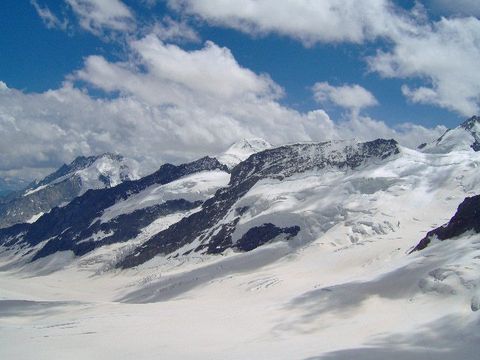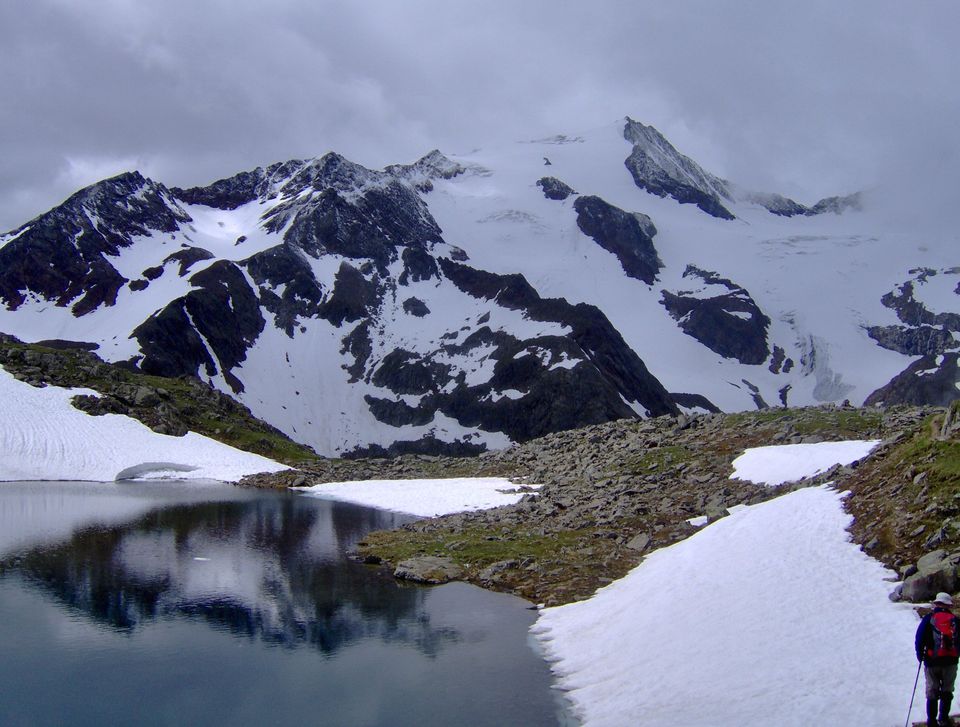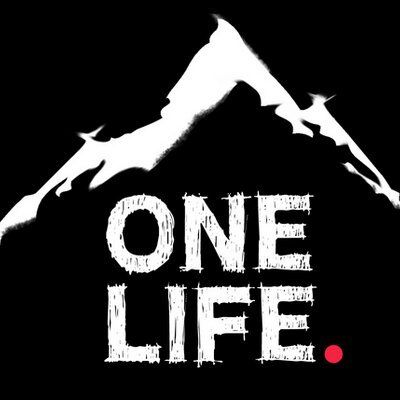The Alpine Pass
The Alpine Pass Route is a long-distance hiking trail through the Alps in Switzerland. It starts in Sargans in eastern Switzerland, and crosses the heart of country westwards to finish in Montreux on the shore of Lake Geneva.
Who Are you
Holly Mills
The Challenge
Trekking the Alpine Pass Route
How long did it take
15 Days
What was the distance
325km
How much did it cost
About £1,500 including travel

What will it be like / was it like
What Was it like
The Alpine Pass Route Crosses Switzerland from East to West from the ancient town of Sargans to Montreux on the shores of Lake Geneva.
Starting in the East through the Bernese Oberland, it covers some 325km of mountain and valley and crosses 16 passes with almost 18,000m of height gain in fifteen stages.
Cicerone are the people who publish the trekking guide – they're brilliant.
Mountain Hut-to-Hut Trekking
Imagine the freshest, cleanest air the bluest skies and a place so quiet that you can hear nothing. I feel as though I have walked back in time.
I’m standing in some snow on top of a mountain, it’s July and I’m up to my ankles in the stuff. It’s taken me a day along the well-marked track to get to here. I started in the sunny valley, walking through old farms, beautiful flowering meadows and peaceful forests. I climbed higher and higher up and round the track past tiny tram stations, and alpine villages. I climbed and climbed. The valley below became smaller as I entered a world that no car could take me to. Twists and turns on the rocky paths and higher I climbed through the clouds. The views were stunning, like nothing I had seen before. Before me a great expanse of glacial mountains and ancient glacial lakes high up in the mountains untouched by man. I felt as though I was the first to discover this ancient land.
Until at last following the track I came across a welcomed sight, in the distance high up in the mountain I could see smoke coming from a chimney of a mountain hut, this was my welcomed destination for the night and a place to eat the best apple strudel on earth!
Introduction
Mountain trekking is an amazing sport for those who love walking and seeing the world in an untouched state. This really is a unique way to walk to places that you would never be able to get to usually. The great thing about trekking is that you can go at your own pace and make your route as long or as short as you like.
As with every sport there are moments that can really challenge you, such as your endurance or parts of the route that you find more technical. But when you reach the summit of a mountain, there is no greater sense of achievement and no better view.
Background
Over the past few summers I have been out to the Austrian and Swiss Alps for hikes lasting around 7-10 days. The walking routes out in the Alps are particularly good as all the major routes are well sign posted and marked every step of the way. There are very easy routes along the valleys, or you can take higher routes (marked out with the red and white signs) that can be more challenging but will take you to some beautiful places and the all-important huts. There are also the high routes (black and white), which are set out for experienced climbers, so these routes are used less frequently when doing the hut-to-hut trekking routes.

How did you train
Firstly try walking for a day somewhere in the UK. Perhaps take a weekend to Wales, Scotland or the Lake District where there are plenty of challenging walks. Spend a day walking up a large hill or mountain and see if you like it and would be happy to spend 7 days or so trekking around a bigger mountain range such as the Alps.

Any other useful hints / links
If you do enjoy trekking then the best way to start is to get a map or a guidebook. I recommend the Cicerone Guides
as they give you realistic detail of what to expect and a map of your route. You will also want to get an OS map of your route.
Plan your route in advance so you know how long you want to spend on your route and in which mountain range you would like to hike. Work out which huts you want to visit during your route and check that walking from one hut to another in a day can be a realistic goal, (the guide books are very useful for this).
(Just as a note, if a days route seems short such as 9km, check the gradient because you could be continuously climbing a steep mountain path and this takes much longer than walking along the mountain ridges).
Once you have decided where you are going and which route you intend to take, go to the Austrian Alpine Club
website and become a member. It will cost you around £30 (annually) and will provide you with discounts at the huts and the essential mountain rescue insurance.
It is also recommended that you go in a group, this way if there are any emergencies then you can work as a team.
What to Take
Now that you have the map, guidebook and the alpine membership it’s time to think about kit.
Take as little as possible. Mountain hiking is a sport where you will wear pretty much the same items of clothing for your entire trek.
Being in the mountains you will notice that temperatures are at the extremes and that the weather can change at any point so the following kit is recommended for your trek.
Here’s what I took in my rucksack: (all good trekking/camping shops will stock the following items).
Rucksack – you need a proper trekking rucksack around 40-50 ltr.
2 x lightweight adjustable walking poles – these are essential for helping you to walk up tricky parts of the route.
1 x pair of walking boots – make sure they fit and practice walking in them before you attempt mountain trekking
Packlite Gortex Raincoat – your raincoat needs to be really lightweight but durable – it is worth investing in a good quality coat.
Light weight fleece
1 x winter hat and gloves (lightweight but warm, it can get very cold and windy)
1 x sun hat
2 x breathable short sleeve t-shirts
1 x long sleeve base layer
1 x trekking trousers – light weight and something that won’t rub (the trousers that un-zip into shorts are useful)
1 x comfortable trekking shorts
Underwear – enough for you trek, cotton is best
2 x Trekking socks – your socks are essential to your trek, as your feet will be put under a lot of stress. Invest in a couple of quality trekking socks –ones that dry quickly are ideal as you will alternate between the two socks throughout the trip
1 x lightweight trousers for the hut
1 x lightweight pair of slippers for the hut
1 x Trekking towel – lightweight and essentially quick to dry
1 x Light weight silk sleeping bag liner
1 x First aid kit
1 x Emergency rations – a large bar of chocolate (only to be eaten in an emergency!)
1 x Whistle (to blow if in danger, 6 long whistle blasts every minute)
1 x 1 ltr water bottle (for example light weight aluminum)
1 x foil rescue bag (you can put yourself in this in an emergency)
1 x mobile phone (this may not work on the mountains but take incase)
Wash bag – deodorant, toothbrush and paste, soap, sun cream
Essential Documents e.g. Guidebook, passport, alpine card, credit card, travel tickets
The secret is to keep your items as lightweight as possible. You will be carrying this kit around with you the whole time, including the steep parts of the route where extra weight can make life harder. It may also seem odd to wear the same clothes all the time, and especially alternate between two pairs of socks. But it is practicality in the huts and out on the mountains not how you look and smell!
From experience I recommend that you bag all of your items up into large clear plastic food bags (easily obtainable from supermarkets). This way if it starts raining your items will stay dry. As an added extra you could also get a rain cover for your rucksack. I really recommend bagging up your items as there is nothing worse than having wet kit and can ruin your trek.
Getting There and Starting the Hike
Before you go check where your route starts and work out how you will get there. Usually the starting points for a trek are in a small valley village or town. There are good bus and train services in the Alps, but check the times and if they are running in the summer.
Once you have arrived at your starting point (if you have not already booked before travelling), head towards the nearest tourist information bureau and find a room for the night. In the Alps, bed and breakfast accommodation is known as a ‘pension’ and you can get very nice overnight accommodation and breakfast for a very reasonable price.
After your first night’s stay, it is time to say goodbye to civilization and begin an amazing journey into the mountains. In the Alps, routes are well marked and the locals will be happy to guide you onto the right path. (Sometimes there are gondolas in the town, so if you don’t want to climb the steep assent to the top, you could always take the cable-car to help you to the first top of the mountain. But don’t think you will have an easy hike if you choose this ‘cheat’ option, as there will be plenty more steep mountain paths to climb!).
Up in the Mountains
When up in the mountains it is important to keep to the footpaths. You may experience some extreme changes in weather. There might be snow or it could get wet and windy all of a sudden and in these conditions it can be harder to see the path markings. Alternatively it could also be extremely hot. Up on a mountain you are closer to the sun, so I found that sun cream is essential.
As previously mentioned, you will see some fantastic sights and also come across some challenges. Some of the paths can be steep and hard work, and in some points you may have to climb a ladder. I would suggest that you go at your own pace and take each challenge as it comes.
The Huts
After a long days trek there is no greater feeling than reaching the hut and taking off your walking boots. Huts are truly unique places and surprising comfortable considering how high up they are. The huts are usually run by families who live up there during the summer months. They are very welcoming and a great place to meet new like-minded friends.
There are some basic rules of etiquette when in the hut. On arrival you will need to take off your boots and put them in the ‘drying room’ along with your walking poles and socks. These rooms are usually easy to find. Once you have done that, you would then need to find the main room and book in for the night (remember to show them your Austrian Alpine card for discounts).
Huts can vary in size and facilities. In some huts you will get your own room but more often than not you will have to share a room with other walkers. Most of the time you will usually find yourself on a bunk bed. However the rooms are very comfortable and the huts usually provide thick duvets and a soft pillow. Nearly all the huts that I visited had hot showers and good washing facilities.
What I love about the huts is the central room that will always have a log burner heating the room. Here you can read a book, play a board game or talk to other walkers about their trekking experiences. The food is also exceptional after a hard days walk and I can highly recommend a slice of apple strudel and a warming hot chocolate! Prices are fairly reasonable and some huts have inclusive or full board offers.
On some occasions the weather can take a turn for the worse and this is when the paths can become inaccessible. If the owner of the hut says that the weather is too bad to go out, then take his word for it, he has many years of experience with the mountains and knows when the paths are too dangerous. Depending on the weather this may mean that you are stuck in the hut for a few extra days, so take this into consideration when planning your trip.
Time to Go
Mountain trekking is such a unique experience and can really change your outlook on life. To ensure you have a great time get prepared before you go and take into consideration all the safety aspects of your trip. If you don’t feel confident the first time you go, you can hire a mountain guide who can lead you to the huts or perhaps persuade a friend who has been trekking to come along with you.
You will see some amazing views and come across some challenges, but as long as you go with an opened mind I can guarantee that you will have to go back and do it all again!
View More Articles
Services List
-
Land This is a text area. Writing in paragraphs lets your visitor find what they are looking for quickly and easily. Edit the text in the list editor.
Land -
Water Expeditions This is a text area. Writing in paragraphs lets your visitor find what they are looking for quickly and easily. Edit the text in the list editor.
Water Expeditions -
Ice Expeditions This is a text area. Writing in paragraphs lets your visitor find what they are looking for quickly and easily. Edit the text in the list editor.
Ice Expeditions
